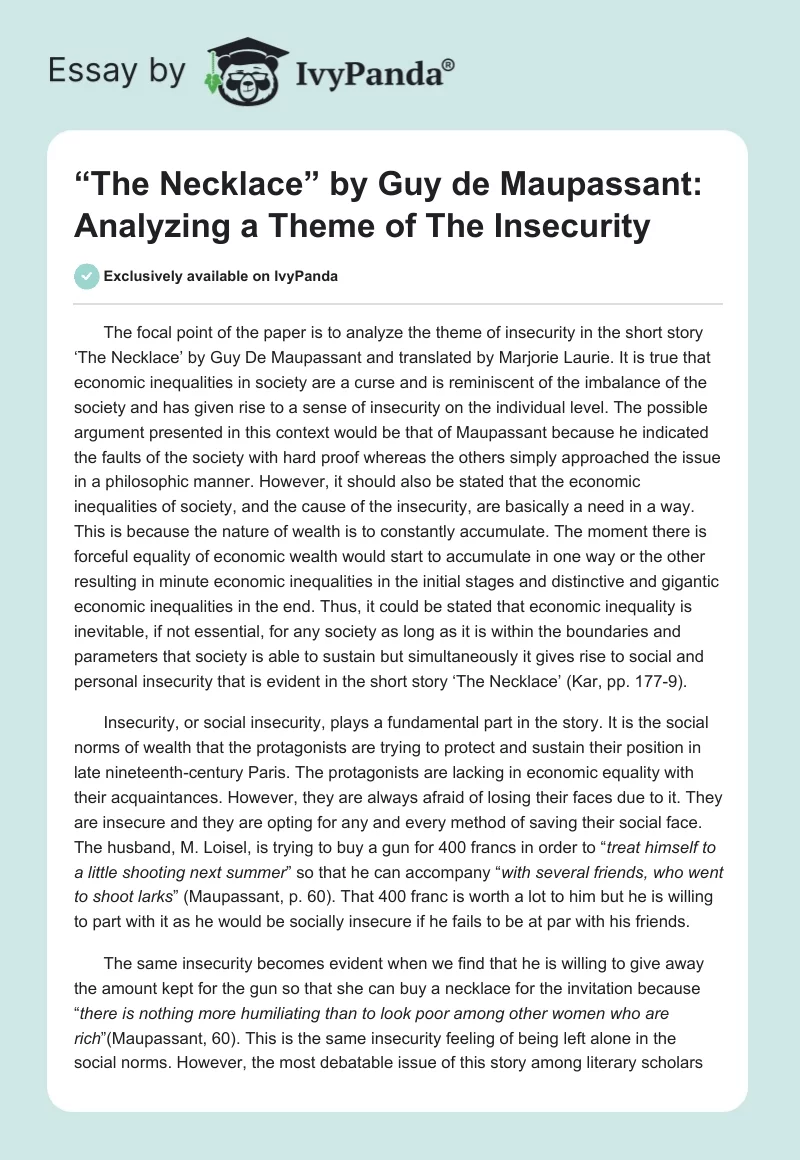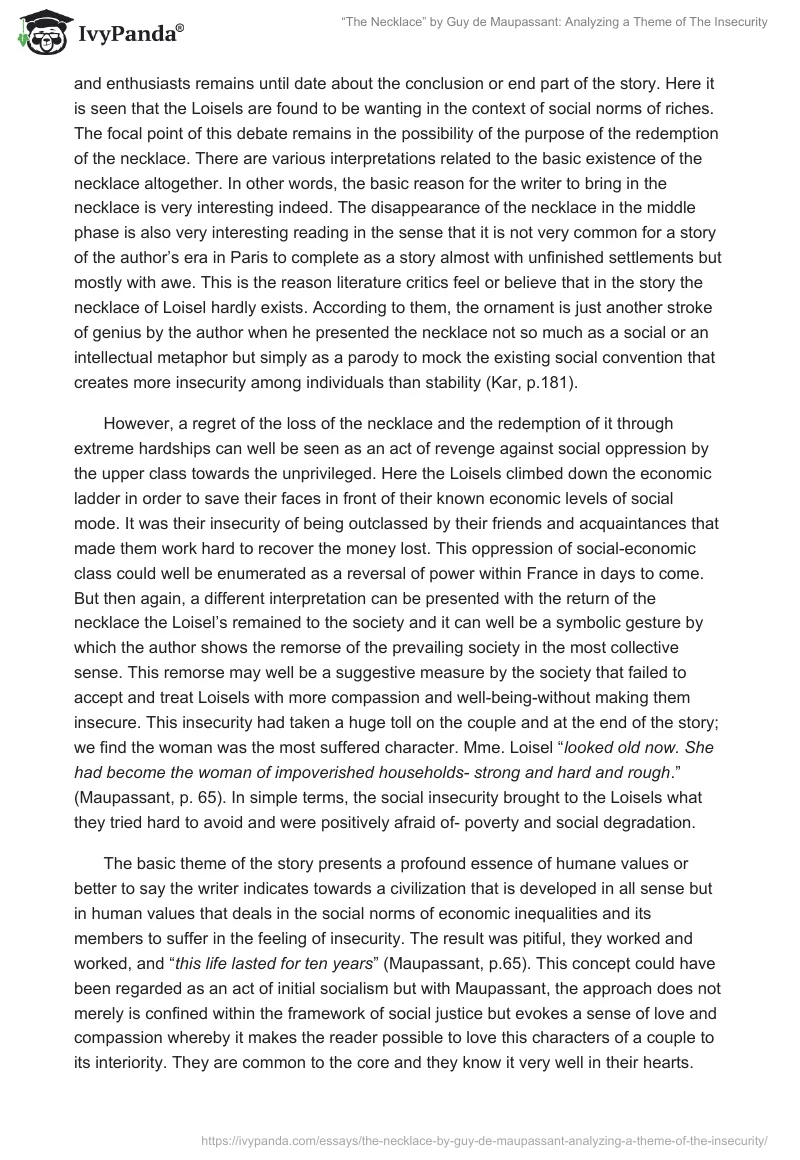The focal point of the paper is to analyze the theme of insecurity in the short story ‘The Necklace’ by Guy De Maupassant and translated by Marjorie Laurie. It is true that economic inequalities in society are a curse and is reminiscent of the imbalance of the society and have given rise to a sense of insecurity on the individual level.
The possible argument presented in this context would be that of Maupassant because he indicated the faults of the society with hard proof whereas the others simply approached the issue in a philosophic manner. However, it should also be stated that the economic inequalities of society, and the cause of the insecurity, are basically a need in a way. This is because the nature of wealth is to constantly accumulate.
The moment there is forceful equality of economic wealth would start to accumulate in one way or the other resulting in minute economic inequalities in the initial stages and distinctive and gigantic economic inequalities in the end. Thus, it could be stated that economic inequality is inevitable, if not essential, for any society as long as it is within the boundaries and parameters that society is able to sustain but simultaneously it gives rise to social and personal insecurity that is evident in the short story ‘The Necklace’ (Kar, pp. 177-9).
Insecurity, or social insecurity, plays a fundamental part in the story. It is the social norms of wealth that the protagonists are trying to protect and sustain their position in late nineteenth-century Paris. The protagonists are lacking in economic equality with their acquaintances. However, they are always afraid of losing their faces due to it. They are insecure and they are opting for any and every method of saving their social face. The husband, M. Loisel, is trying to buy a gun for 400 francs in order to “treat himself to a little shooting next summer” so that he can accompany “with several friends, who went to shoot larks” (Maupassant, p. 60). That 400 franc is worth a lot to him but he is willing to part with it as he would be socially insecure if he fails to be at par with his friends.
The same insecurity becomes evident when we find that he is willing to give away the amount kept for the gun so that she can buy a necklace for the invitation because “there is nothing more humiliating than to look poor among other women who are rich”(Maupassant, 60). This is the same insecurity feeling of being left alone in the social norms. However, the most debatable issue of this story among literary scholars and enthusiasts remains until date about the conclusion or end part of the story. Here it is seen that the Loisels are found to be wanting in the context of social norms of riches.
The focal point of this debate remains in the possibility of the purpose of the redemption of the necklace. There are various interpretations related to the basic existence of the necklace altogether. In other words, the basic reason for the writer to bring in the necklace is very interesting indeed. The disappearance of the necklace in the middle phase is also very interesting reading in the sense that it is not very common for a story of the author’s era in Paris to be completed as a story almost with unfinished settlements but mostly with awe. This is the reason literature critics feel or believe that in the story the necklace of Loisel hardly exists. According to them, the ornament is just another stroke of genius by the author when he presented the necklace not so much as a social or an intellectual metaphor but simply as a parody to mock the existing social convention that creates more insecurity among individuals than stability (Kar, p.181).
However, a regret of the loss of the necklace and the redemption of it through extreme hardships can well be seen as an act of revenge against social oppression by the upper class towards the unprivileged. Here the Loisels climbed down the economic ladder in order to save their faces in front of their known economic levels of social mode. It was their insecurity of being outclassed by their friends and acquaintances that made them work hard to recover the money lost. This oppression of socioeconomic class could well be enumerated as a reversal of power within France in days to come.
But then again, a different interpretation can be presented with the return of the necklace the Loisel’s remained to the society and it can well be a symbolic gesture by which the author shows the remorse of the prevailing society in the most collective sense. This remorse may well be a suggestive measure by the society that failed to accept and treat Loisels with more compassion and well-being-without making them insecure. This insecurity had taken a huge toll on the couple and at the end of the story; we find the woman was the most suffered character. Mme. Loisel “looked old now. She had become the woman of impoverished households- strong and hard and rough.” (Maupassant, p. 65). In simple terms, the social insecurity brought to the Loisels what they tried hard to avoid and were positively afraid of- poverty and social degradation.
The basic theme of the story presents a profound essence of humane values or better to say the writer indicates towards a civilization that is developed in all senses but in human values that deal in the social norms of economic inequalities and its members to suffer in the feeling of insecurity. The result was pitiful, they worked and worked, and “this life lasted for ten years” (Maupassant, p.65). This concept could have been regarded as an act of initial socialism but with Maupassant, the approach does not merely is confined within the framework of social justice but evokes a sense of love and compassion whereby it makes the reader possible to love this character of a couple to its interiority. They are common to the core and they know it very well in their hearts. The sense of consumerism is virtually overwhelming in them but it is the maintaining status and insecurity of losing it that comes out as the most instrumental determinant (Lamb, p. 227).
Works Cited
- Maupassant, Guy De; The Necklace; trans. Marjorie Laurie; pp. 59-65; 1934
- Kar, P; Consumer Market in Literature (Kolkata: Dasgupta & Chatterjee 2005) p. 145
- Lamb, Davis; Cult to Culture: The Development of Civilization; (Wellington: National Book Trust. 2004)


